Ray and Halo Impact craters on Ganymede: Insights into stratification of icy crust
- 1German Aerospace Center (DLR), Institute of Planetary Research, Berlin, Germany (namitha.baby@dlr.de)
- 2University of Freiburg, Freiburg, Germany
Introduction
Ganymede, the largest moon in the solar system, presents a compelling subject for studying icy moons due to its unique geological processes compared to its neighbors. As a result, it is now the primary target of ESA's JUICE mission [1, 2]. Predominantly, impact craters dominate its terrains, each exhibiting a distinctive morphology and ejecta pattern. These features help to understand the vertical stratigraphy of Ganymede's crust at a local scale. Additionally, our study investigates the role of spreading and rifting processes in transporting dark terrain material to the subsurface.
Data and Methodology
We identified four crater types for our study: Bright Ray Craters (BRCs) with bright ray ejecta, Dark Ray Craters (DRCs) with dark ray ejecta, Craters with both bright and dark ejecta (DBRCs), and Dark Halo Craters (DHCs) with circular to subcircular dark ejecta. We utilized the global mosaic from [3]. We examined several craters also observed by Galileo NIMS, with spatial resolutions up to ~2 km/pxl [4, 5]. We mapped the band depth (BD) of one of the major water ice absorptions at 1.5 or 2 µm to derive information on the relative abundance of water ice versus dark material following the approach presented in [6]. Morphologic details of the craters, including inner features and the extension of their halos or ray systems, were mapped.
To calculate excavation depth, we use equation from [7],
De = 1/10* Dt (Eq. 1),
where De is the maximum depth of excavation, and Dt is the diameter of the transient crater cavity.
To determine the transient diameter (Dt) of a crater with known final crater diameter (D), we employ the equation by [8].
D = Dtε ⋅ Dc1−ε [8] (Eq. 2)
Dc = 2.5 km for Ganymede, ε ~ 1.13, which accounts for crater slumping [8]
Results
Distribution of crater types
In this study, we analyzed 36 impact craters on Ganymede (Fig. 1), categorizing 3 as DHCs and the rest as ray craters. Among these, the ray crater Tammuz (DBRC) exhibits half bright and dark ejecta. In detail, 20 craters are situated in the light terrain, 8 in the dark terrain, and 8 were emplaced along the boundary between light and dark terrain.
Excavation depths of crater types
Craters with dark ejecta predominate below 40 km diameter, while beyond 40 km, BRCs prevail (Fig. 2 a and b). Dark terrain material originates from excavation depths of up to 3 km in light terrain. Larger ray craters located at the borders of light and dark terrain are observed to be BRCs (Fig. 2c).
Individual Craters
1. Antum
Antum, a DRC ~ 15 km in diameter, is situated at around 5.5°N/141.1°E on dark terrain, with a maximum excavation depth of ~ 1.2 km (Fig. 3). Its main geological features include a crater with a distinct floor and rim, as well as extended dark rays. This is supported by the BD map of water ice absorption at 1.5 µm, derived from NIMS observations, indicating enrichment of water ice in the crater (smaller ice grains) and dark non-ice material in the ray material (larger ice grains).
2. Kittu
Kittu, a 15 km DRC, is situated at ~ 0.5°N/25°E on light terrain (Fig. 4). The maximum excavation depth is ~ 1.2 km. The main geological units are a central peak, a bright rim and floor, a continuous bright ejecta and discontinuous dark ejecta. NIMS confirms richness in water ice and smaller ice grains in colder water ice while low water ice abundance and larger ice grains in warmer dark ejecta.
Discussion
To explain craters like Antum, the depth of excavation for dark ejecta should match the thickness of the top dark terrain material (Fig. 5a). In the Antum region, dark terrain thickness reaches ~1.2 km. Conversely, for craters like Kittu (Fig. 5b) on light terrain, dark ejecta suggest that dark material is relatively thin and comes from a layer just beneath the surface, ~1.2 km. Dark material reaching such depths could be attributed to tectonic rifting, necessitating mechanisms for material transport. These findings provide constraints for future assessments of light terrain formation processes and dark material transport mechanisms.
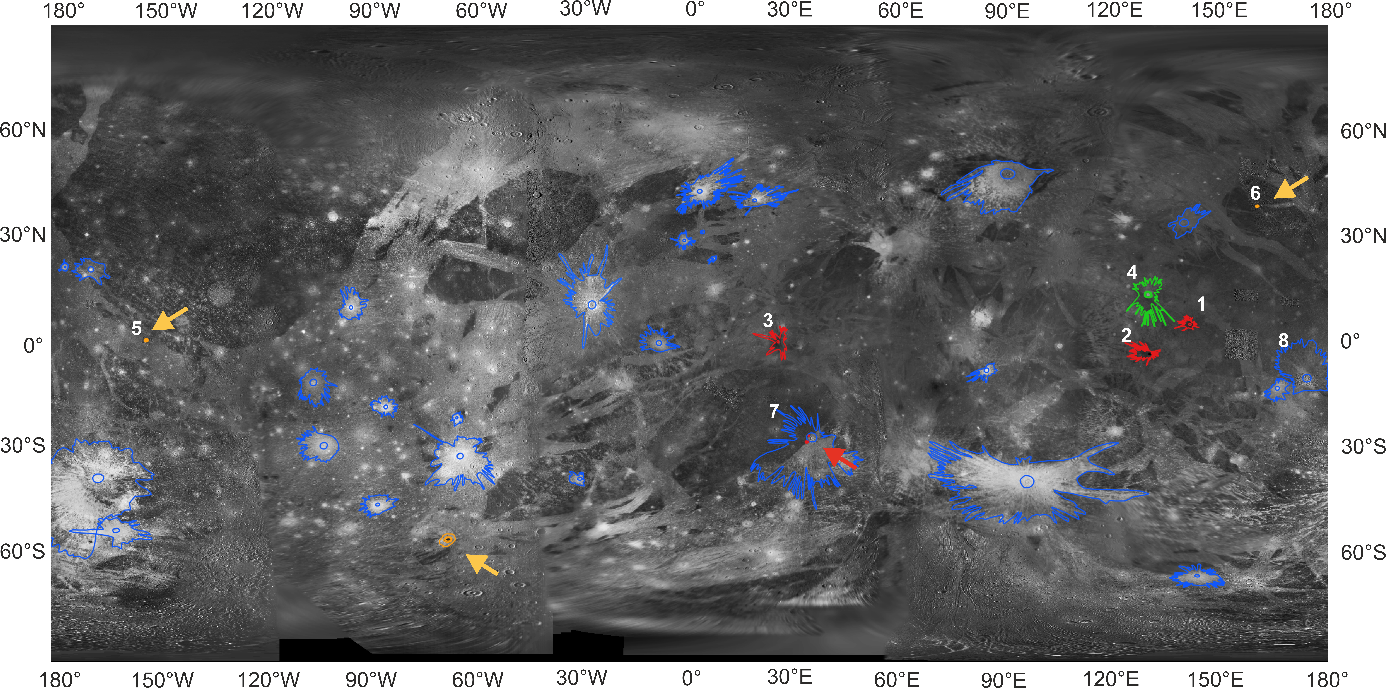
Figure 1: The global distribution of BRCs (blue), DRCs (black), BDRCs (green), and DHCs (yellow) on Ganymede.
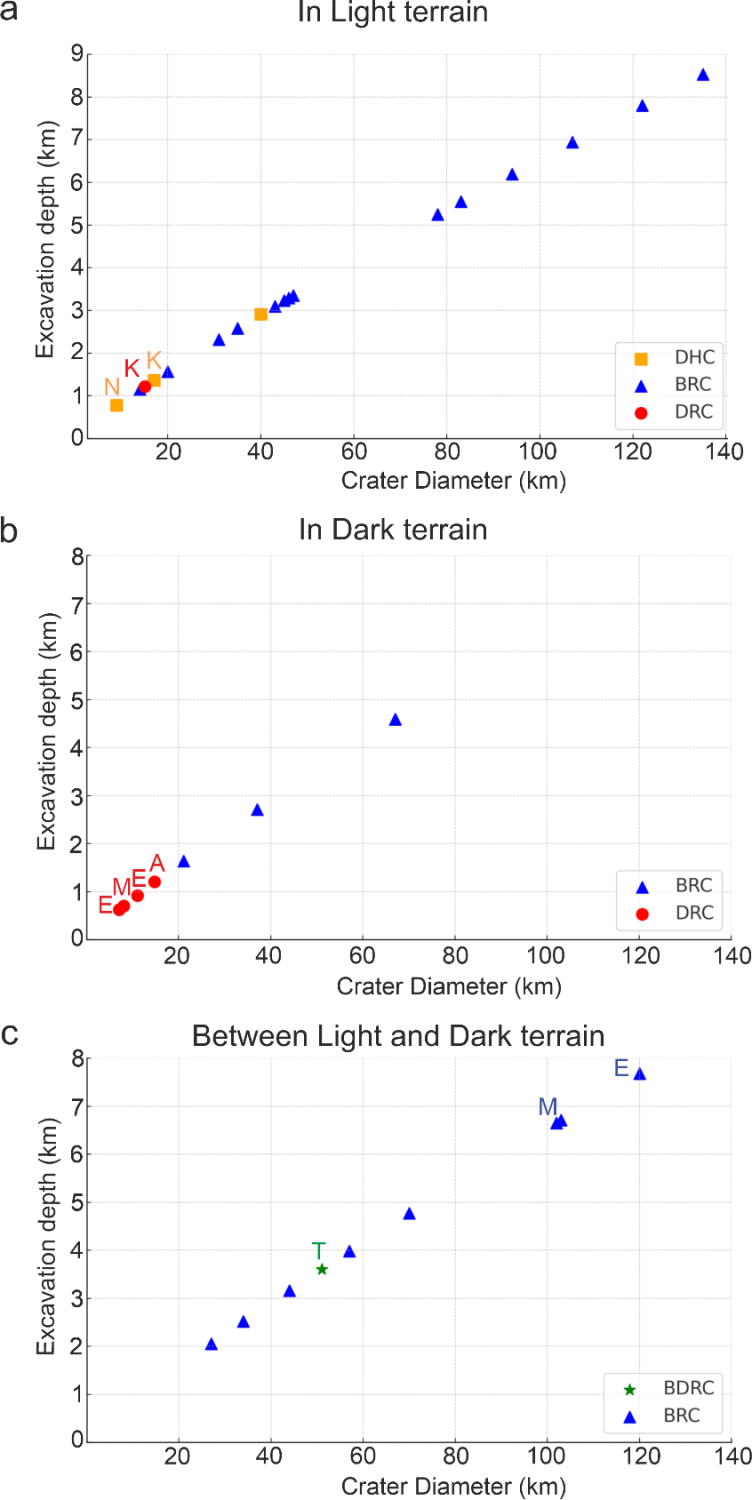
Figure 2: Crater diameter vs. excavation depth (km) for various crater types and terrains: a) craters located in light terrain, b) in dark terrain and c) at border between light and dark terrains.
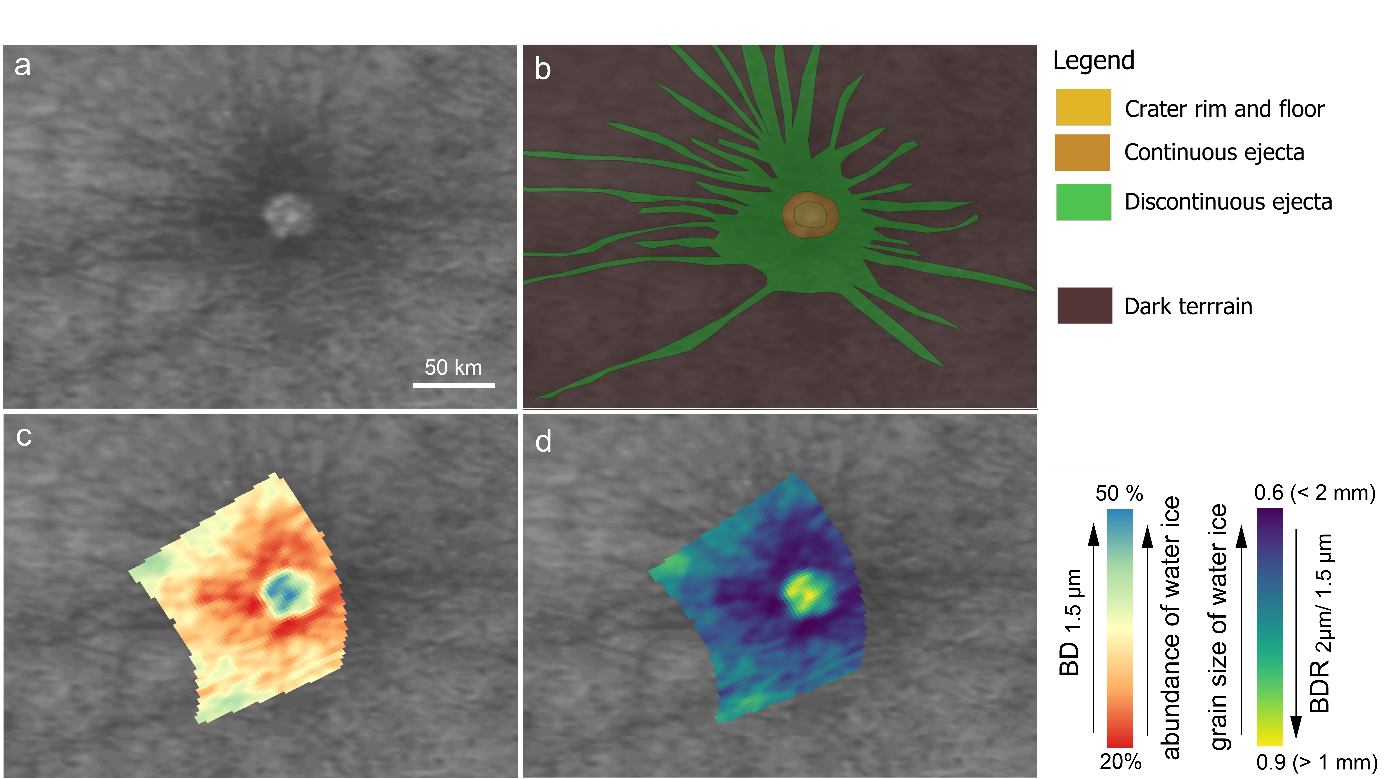 Figure 3: Dark ray crater (DRC) Antum: a) Voyager image, b) geologic map, c) NIMS derived BD map of the water ice absorption at 1.5 µm and d) grain size of water ice as derived by the NIMS BDR map of the water ice absorptions at 2 and 1.5 µm after [6].
Figure 3: Dark ray crater (DRC) Antum: a) Voyager image, b) geologic map, c) NIMS derived BD map of the water ice absorption at 1.5 µm and d) grain size of water ice as derived by the NIMS BDR map of the water ice absorptions at 2 and 1.5 µm after [6].
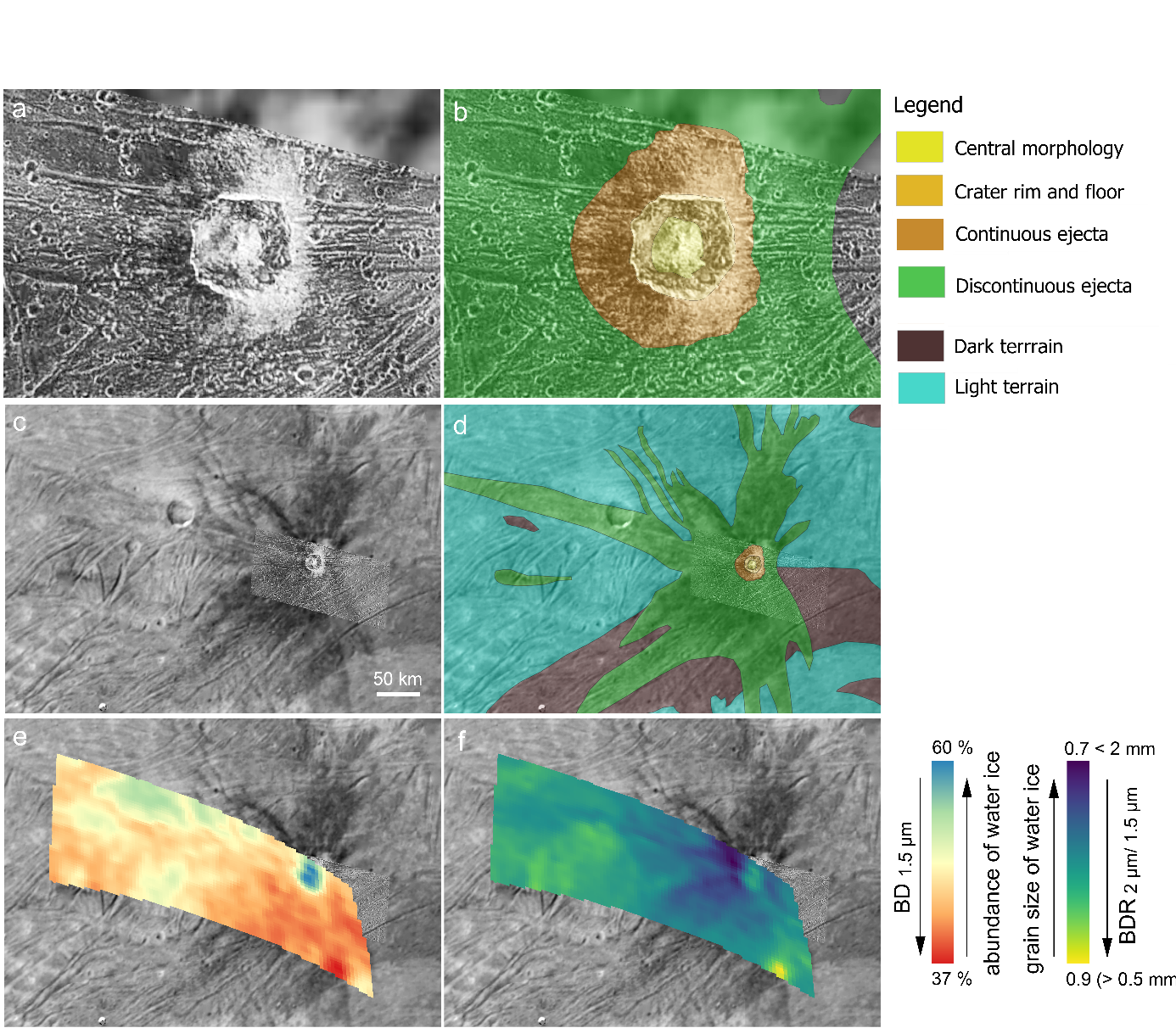
Figure 4: Dark ray crater (DRC) Kittu: a) High resolution Galileo observation, b) geologic map of Kittu crater, c) Voyager + Galileo mosaic, d) geologic map, e) NIMS derived BD map of the water ice absorption at 1.5 µm and f) grain size of water ice as derived by the NIMS derived BDR map of the water ice absorptions at 2 and 1.5 µm after [6].
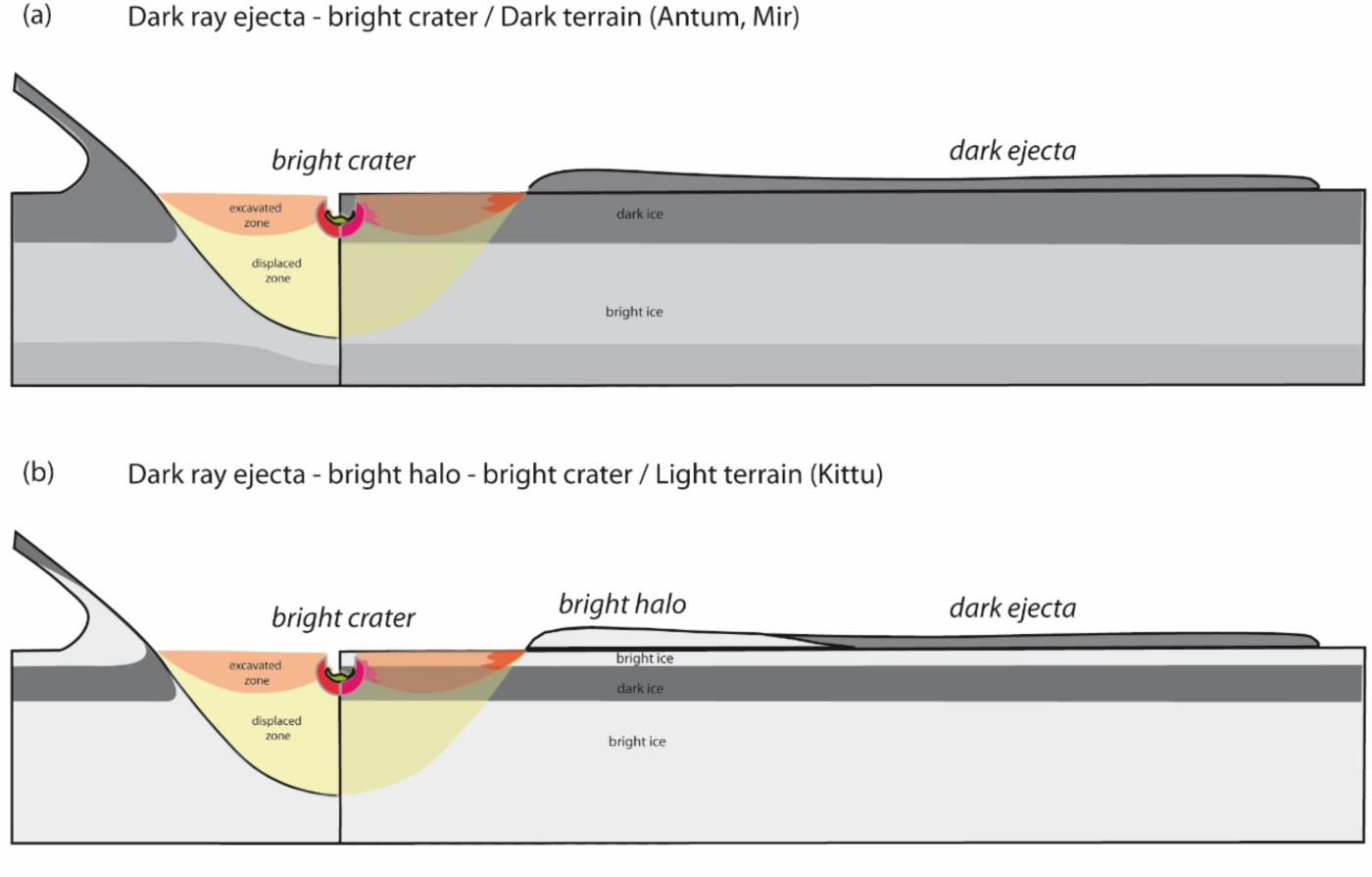
Figure 5: Schematic illustration of the subsurface layers required to explain various ejecta pattern. In the left part is the transient cavity illustrated and how the different layers are involved in the ejecta curtain. The larger right side shows the ejecta blanket and the position of different ice layers of the target prior to impact. The shown scenarios are applicable to craters a) DRC Antum (on dark terrain) b) DRC Kittu (on light terrain) .
References:
[1] Grasset, O., et al., Planetary and Space Science, 78, 1-21, 2013. [2] Stephan, K., et al., Planetary and space science, 208, 105324, 2021. [3] Kersten, E., et al., EPSC2022-450, 2022 [4] Stephan, K., et al., ScSSI, abstr. 9060, 2008. [5] Hibbitts, C. A., Icarus, 394, 115400, 2023. [6] Stephan, K., Icarus, v. 337, p. 113440, 2020. [7] Melosh, H. J., ISBN 0 19 504284 0, 245 pp, 1989. [8] Schenk, P. M., Cambridge University Press, p. 427 – 456, 2004
How to cite: Baby, N. R., Kenkmann, T., Stephan, K., Wagner, R., and Hauber, E.: Ray and Halo Impact craters on Ganymede: Insights into stratification of icy crust, Europlanet Science Congress 2024, Berlin, Germany, 8–13 Sep 2024, EPSC2024-633, https://doi.org/10.5194/epsc2024-633, 2024.